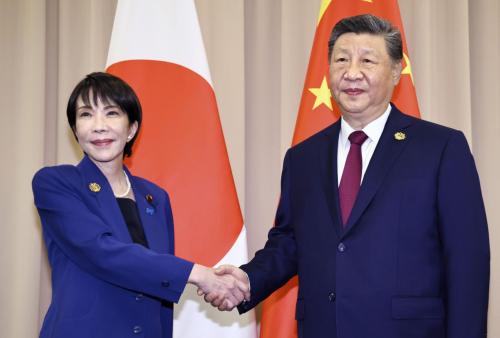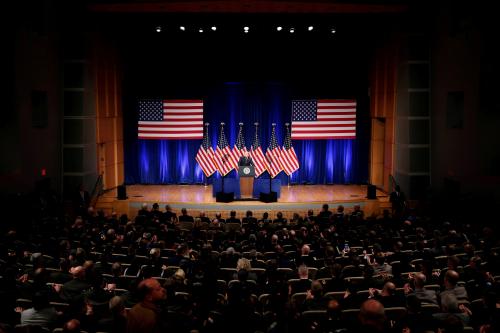On October 1, the Department of State released the data exchanged between the United States and Russia in September under the terms of the New Strategic Arms Reduction Treaty (New START). The data shows that, while Russia has reduced its deployed strategic warheads and deployed missiles and bombers to levels below New START’s limits, U.S. strategic forces remain well above. The United States should accelerate treaty implementation, particularly of the limit on deployed strategic warheads.
The New START Treaty entered into force in February 2011. It requires that, by February 2018, the United States and Russia each reduce its strategic forces to no more than 1550 deployed strategic warheads on no more than 700 deployed strategic missiles and bombers. The treaty also limits each side to no more than 800 deployed and non-deployed strategic missile launchers and bombers.
According to the latest data exchange, in September Russia had 1400 deployed strategic warheads on 473 deployed missiles and bombers, below the New START limits, while the United States maintained 1688 strategic warheads on 809 deployed missiles and bombers. With regard to deployed and non-deployed launchers and bombers, the United States and Russia both remain above the treaty limit, at 1015 and 894, respectively. The Arms Control Association’s Greg Thielmann examined the pace of U.S. reductions over the past two-and-a-half years and termed it lethargic.
The White House should direct the Department of Defense to accelerate treaty implementation, at least as regards achieving the 1550 limit on deployed strategic warheads—New START’s most important constraint. (In the nuclear world, what goes up, missiles and bombers, will matter less than what comes down, nuclear warheads.)
First, U.S. strategic forces do not require the additional warheads. In the ratification process for New START, the senior military leadership made clear that they could maintain a robust and effective nuclear deterrent at 1550. Moreover, they validated the proposal that President Obama announced in June to reduce the 1550 limit by one-third.
The excess warheads make no additional contribution to U.S. security. Neither North Korea nor Iran nor any other potential adversary will act more aggressively toward the United States if it has “only” 1550 strategic warheads instead of 1688.
Second, achievement of the deployed strategic warhead limit on an accelerated basis, say sometime in 2014, would underscore the administration’s commitment to reducing nuclear weapons numbers and their role in U.S. national security policy. It could prove an important point at the 2015 review conference of the Non-Proliferation Treaty, when the nuclear weapons states, particularly the United States and Russia, can expect hard questions from non-nuclear weapons states about their arms reduction policies.
Some argue that accelerated U.S. implementation could help induce Moscow to consider further reductions below the limits in New START. That could be the case, though the current reasons behind President Putin’s evident reluctance to pick up President Obama’s June offer are difficult to discern. They may stem as much or more from Russian domestic political considerations and Kremlin self-image factors as from strategic calculations. In any event, accelerating U.S. reductions to 1550 would certainly do no harm to the effort to bring Russia to a more enlightened course on nuclear arms.
The focus on accelerating the reduction of U.S. warheads to the limit of 1550 flows not only from the fact that that limit is the most important of the three numerical constraints in New START. Warhead reduction, which simply requires removal of ballistic missile warheads from intercontinental and submarine-launched ballistic missiles (ICBMs and SLBMs), can be accomplished relatively easily.
Accelerating reductions to implement the other two New START limits poses more complicated questions. Removing deployed ICBMs from silos or SLBMs from submarine launch tubes to reach the 700 limit is a more complex process than removing warheads from ballistic missiles.
Eliminating launchers or converting them so that they cannot launch missiles and thus are not counted under New START’s 800 limit requires time and raises questions of cost and impact on normal operations. The U.S. Navy plans to convert four of the twenty-four launch tubes on its Ohio-class ballistic missile submarines so that they cannot launch SLBMs. In order to minimize cost and operational impact, however, such work will be scheduled so that, as much as possible, it takes place when submarines are in the shipyard for other maintenance.
So warheads can be reduced more quickly than deployed missiles or launchers. A more rapid reduction of warheads could well lead to a situation where some deployed ICBMs and SLBMs have no deployed warheads. That might seem unusual, but it would not be prohibited under New START. During Russian inspections, any such deployed missiles would be declared as having no warheads, and Russian inspectors would have the option of choosing one of those missiles to confirm that it carried no warheads.
Speeding up the reduction of U.S. deployed strategic warheads would be a relatively simple process, poses no security risks, underscores the administration’s commitment to reduce the role and number of nuclear weapons, and strengthens Washington’s non-proliferation credentials. President Obama should set a deadline for achieving the 1550 limit in 2014 and instruct the Department of Defense to make it happen.
The Brookings Institution is committed to quality, independence, and impact.
We are supported by a diverse array of funders. In line with our values and policies, each Brookings publication represents the sole views of its author(s).



Commentary
Accelerate New START Implementation
October 8, 2013